ABOUT THE PROJECT
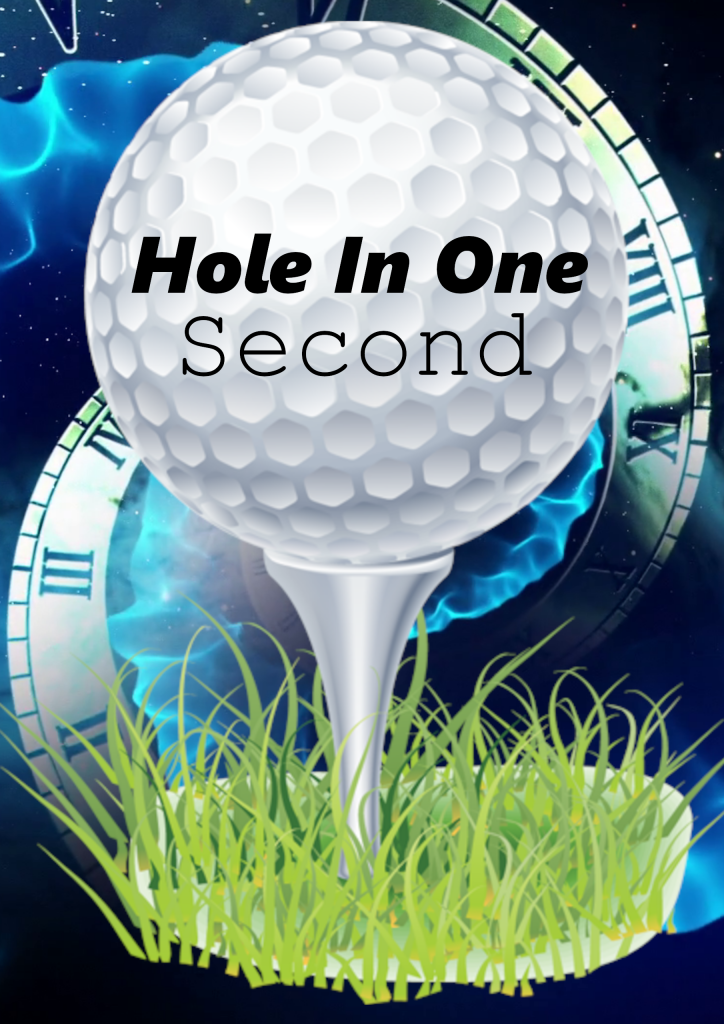
In this Futuregames project we set out to develop several protoypes of mechanics that all follow the same key words:
Time Controlling Mini Golf Bullet Hell.
• Role: Gameplay Designer
• Project Length: 2 weeks
• Engine: Unity
•Genre: Casual/Simulation
• Team Size: 4
(2 designers and 2 programmers)
WORKFLOW & CONTRIBUTIONS
At first, we planned to only do a mini golf bullet hell game. However, in a bullet hell scenario the impact of the bullets can shoot the golfball in an altered trajectory and potentially trapping the ball in a never ending cycle of bounces. We decided to implement a time mechanic to ensure that the player will have a window where they can always hit their ball even if it is en route to collide with something. Controlling the time mechanic in different ways guarantees that the player will always be able to shoot their ball in some way. Thus, time controlling mini golf in a bullet hell scenario was born.
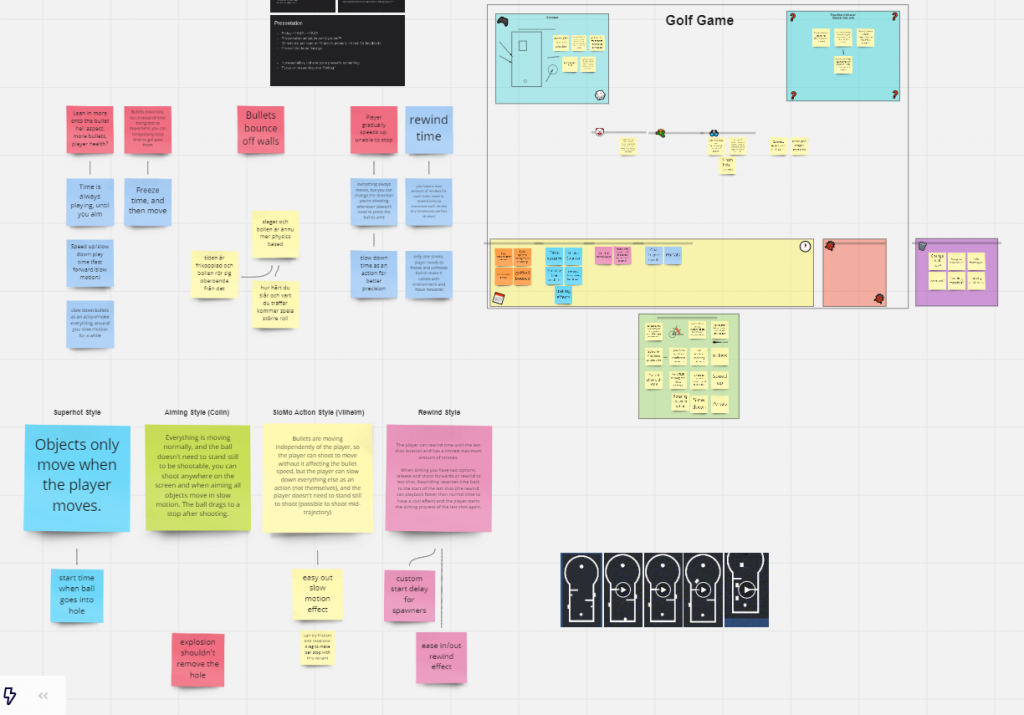
After we finished brainstorming the different mechanics and mapping out the project using rough sketches and post-it notes on our Miro board, my primary task became to communicate the details of the mechanics to the programmers. I asked for specific exposed variables so that I could tweak and balance the look and feel of the gameplay as they moved onto the next task.
We started with the core player mechanics and then continued with physics and time. This process was done continuously as more and more specific information was needed for the programmers to realize the design vision. During the entirety of the project I conducted extensive playtesting on all prototyping stages to nail the variable values and ensure an intuitive game feel that I mediated to the team.
PROTOTYPE ONE
Obstacles Move When Ball Moves
The first prototype was inspired by the game SUPERHOT (2016), with the main idea being that obstacles only move when the player shoots their ball. The goal is to get the golf ball into the hole with as few strokes as possible, which will be challenging due to the player needing to predict the movements of the objects in the scene in relation to their own as they start and stop time with their strokes.
The player’s ball and the obstacles are technically always moving, so with each stroke the player simply changes the trajectory of the ball and the duration when time is active and not frozen. We decided to follow the rules of regular mini golf with allowing the player to only shoot the ball when it is standing completely still, in order to facilitate moments when time is frozen. Our aim was to ensure that players would easily understand that all objects only move when their ball does.
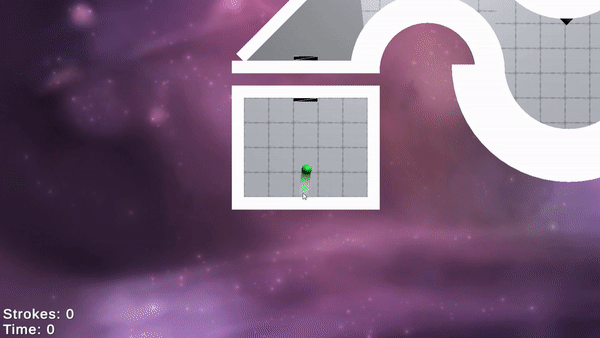
While this mechanic significantly slows down the pacing of the bullet hell aspect it gives the player a strategic sense of control where they can calculate the moving objects in the scene like an obstacle course in relation to the player. In the end, the first prototype turned out to suit a strategic playstyle.
PROTOTYPE TWO
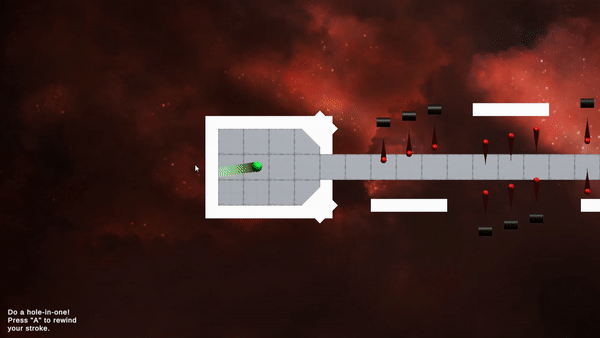
Rewind Your Last Shot
In the second prototype we took time in a different direction, namely backwards. Being able to rewind time to before your last stroke makes it so that the last stroke basically never even happened. However, instead of simply cutting back to that point we decided to playback the time as a visual effect that would explain what happened more clearly to the player.
In this prototype the player doesn’t really have any control over the bullets as they have in the other prototypes, since we normalize the bullet hell aspects by not having any actions be dependent on the player’s ball.
We found that the ability to rewind time in a mini golf setting promotes making every shot perfect, since you can retry the same shot again and again without it affecting your stroke count. The second prototype turned out to be a hole-in-one simulator.
PROTOTYPE THREE
Slow Motion When Aiming
In the third prototype we experimented with the player’s input. Slowing down time while the player was aiming made it easier to predict the bullets trajectories in relation to the player. Pairing that with the player being able to alter their trajectory with a new shot on the fly meant that the gameplay remained fast paced even when slow motion was activated.
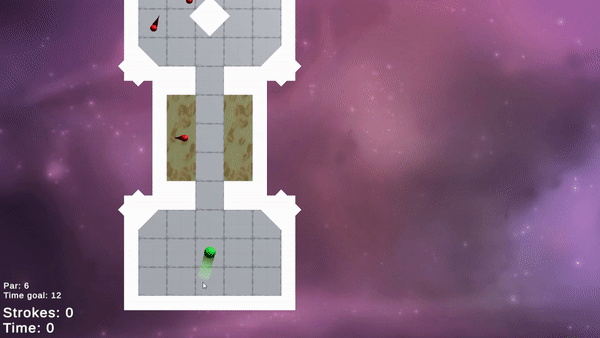
We stopped following the rules of mini golf where you can only hit the ball when it’s standing still, and not needing to click the ball to start aiming felt very user friendly since clicking the on ball every time was both unnecessary due to there only being one player actor in the scene, and very hard to do if the ball was in motion.
The Slow Motion Aiming prototype did a great job of encapsulating all the feelings of the desired aspects of our game. It felt like time was being controlled in a bullet hell scenario that originated from mini golf, since the independent movements of the bullets made the bullet hell aspect both potent and readable.
PROTOTYPE FOUR
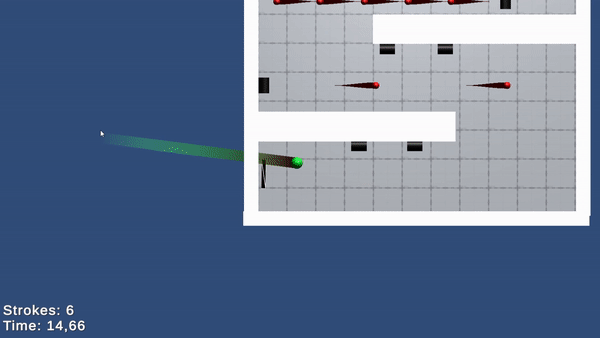
Slow Motion as an Action
In the fourth prototype we retained the free form of being able to shoot whenever and without needing to click directly on the ball. Being able to slow down time at will with an action made it easier for the player to execute their movements, even if only for a limited time. In a bullet hell scenario with many obstacles the player could then momentarily create a clear path to go through.
To combat that the player just goes through a completely frozen level we added a cooldown to the ability. We indicate the availability of the time slow ability by changing the color of the ball’s trail. As time is slowed the trail is a bright red, while the effect then is on cooldown the trail is a deep blue, and when the ability is ready to be used again the trail returns to pink.
Having the player being able to change their trajectory midair and also slow time meant that this prototype introduced a clear skill cap with a need of mastery to perform efficiently. In the beginning it is quite hard to use the ability and achieve the exact results that you want, but with mastery of the skill the player has a very strong tool for strategy at their disposal.
ITERATIONS
Each prototype required several iterations to ensure a smooth game feel. As an example, during the development of the first prototype we discovered that trail effects, pacing and camera movements were all important factors for the game to be easy to understand and more enjoyable. These discoveries made their way into all the following prototypes.
First Prototype : v1.
First Prototype: v2.
First Prototype: v3.
First Prototype: v4.
CLOSING THOUGHTS
This project provided great insights into the benefits of prototyping different versiones of the same mechanics. It taught me that the first idea might not be what’s the best and that you should always explore your options as much as you can. I personally enjoy the third protoype’s Slow Motion Aiming playstyle the most but I can see several of these prototypes being developed into their own games.
TEAM MEMBERS
GAME DESIGNERS
• Per Hallros
• Lukas Sivertsson
PROGRAMMERS
• Vilhelm Stokstad
• Colin Brook
Cool of you to check this project out, I hope you liked it!
